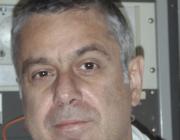Abstract:
{We present the results of a dense seismological experiment in the western part of the Gulf of Corinth (Psathopyrgos-Aigion area), one of the most active rifts in the Aegean region for which we have precise tectonic information. The network included 51 digital stations that operated during July and August 1991, covering a surface of 40 times 40 km2. Among the 5000 recorded events with ML ranging between 1.0 and 3.0, we precisely located 774 events. We obtained 148 well-constrained focal mechanisms using P-wave first motions. Of these, 60 also have mechanisms obtained by combining the P-wave first motions with the S-wave polarization directions. The observed seismicity is mainly located between 6 and 11 km depth. Most of the fault-plane solutions correspond to E-W-striking normal faulting, in agreement with the geological evidence. Most of the well-determined mechanisms indicate a nodal plane dipping 10–25° due north and a steep south-dipping plane. A similar asymmetry is also seen in the seismicity distribution and in the overall geological structure of the Corinth Rift. We discuss this evidence and the inference of a deep detachment zone, a structure where the major faults seen at the surface appear to root. A large part of the microseismic activity appears to cluster in regions near the junctions of the main faults with the proposed detachment zone. This feature of the microseismicity is interpreted in terms of stress transfer and stress concentration in regions of probable nucleation of future large earthquakes.}
Publisher's Version

